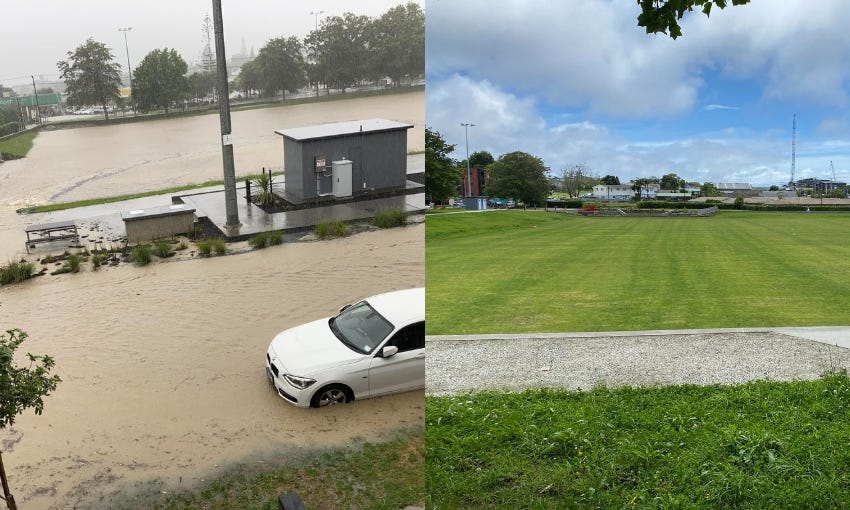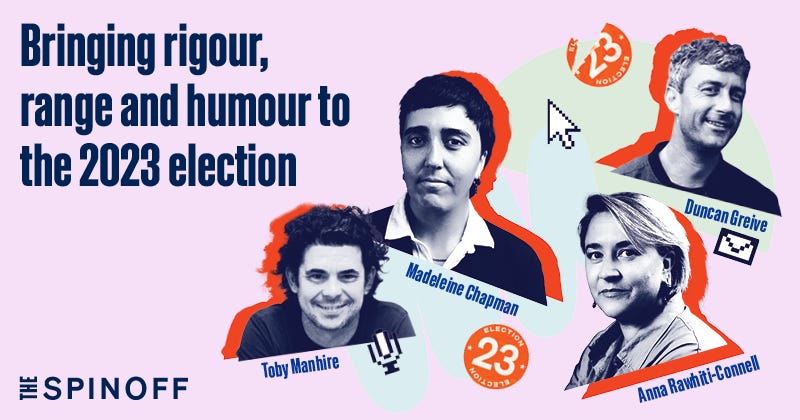When your local footy field is also a flood basin
We’ve already built communities on floodplains. How can we build resilience?
Kia ora, welcome to Future Proof! I’m Ellen, thanks so much for joining me this week.
Greenslade Reserve in Northcote during the Auckland Anniversary Weekend floods, and 15 hours later. Image credit: Kāinga Ora.
During the Auckland anniversary weekend floods, Greenslade Reserve in Northcote became a lake of muddy brown water. Fifteen hours later, 12 million litres of floodwater had drained, and it was back to being a playing field.
That’s exactly what it was designed to do, says Mark Fraser, the general manager of urban development and delivery at Kāinga Ora. “It was designed to fill in a big rainfall event, to slow all that water down, which would have otherwise rushed through the town centre and houses on the way to the sea,” he says. Historically, less intense downpours would’ve flooded the Northcote town centre and nearby housing. This time, despite the record-breaking wet, the suburb – and its 1700 new Kāinga Ora homes – stayed comparatively dry.
Kāinga Ora, in partnership with Auckland Council’s Healthy Waters, had completed a redevelopment of the reserve just last year. They lowered the playing fields by about 1m and underlaid the turf with a sandy bed to help water drain through a network of pipes to the harbour. Daylighting the nearby Awataha Stream – that is, restoring it to its natural, above-ground state – also relieved pressure on the stormwater network.
The project is an example of how Kāinga Ora is building resilience alongside houses across Tāmaki Makaurau, Fraser says. Similar stormwater projects in Roskill South and Ōwairaka produced equally encouraging results, with floodwaters spilling down “planned pathways” instead of into people’s homes. Because the government agency undertakes urban development at large scale, it has the resources – and duty – to tackle accompanying climate adaptation for communities. It’s already commissioned a report from Niwa, revealing that around 16% of its portfolio is vulnerable to floods. Now the job is figuring out how to protect them.
The future of Māngere
Next on the list for flood resilience is the south Auckland suburb of Māngere, where several Kāinga Ora homes suffered flood damage. While the government agency copped flak for 590 flood damaged homes across the city (among a total of 6,000–8,000), Fraser says the newest individual homes were built to exceed Council stormwater standards. To weather a 1-in-200-year storm like the Anniversary floods, the neighbourhood needs “a stormwater solution that makes the wider suburb flood resilient” – something like Greenslade Reserve. Some older houses in the lowest part of the catchment that were severely flood damaged won’t be rebuilt, with the land potentially repurposed for flood attenuation. New hydrological modelling completed last year, as well as data from this year’s weather events, means Kāinga Ora and Auckland Council have a much better idea of what infrastructure will be required to keep people in Māngere safe and dry.
‘Houses where they shouldn’t be’?
An offhand comment from mayor Wayne Brown in the aftermath of the flood ignited a debate about where New Zealand builds houses. But Fraser points out that we’ve already built entire communities on floodplains: “the majority of New Zealand's towns and cities are built on rivers and harbours,” he says. “So as a country, we should not be that surprised that from time to time some are going to flood.” Managed retreat might be needed in some cases, but instead of turning our backs on entire communities, Fraser argues, we should invest in them to boost their resilience. “The development [Kāinga Ora does] generates the economic activity and the land use changes that make it possible and worth our collective while to fix the resilience of the suburbs. We can make that existing suburb better for the people that already live there, and the future people that are going to live there.”
Become a Spinoff member and support our Election 2023 coverage
The Spinoff is raring to go in what has become the election of the minor parties. For what is The Spinoff if not a minor party in the beehive of New Zealand media? We want to cover this year's election with rigour, range and humour but to do so, we need your help. The financial support of our members is essential, particularly during an election. It will help us cover increased editorial and travel costs, up our presence in the press gallery and do more on-the-ground reporting on the campaign trail. Every donation allows our writers to chase the big stories, no matter where in the country they are. If you aren’t already, become a Spinoff Member by making a donation today.
Madeleine Chapman, editor
MfE presents four options to refocus ETS away from pines
As readers of Future Proof hopefully know, we can’t offset our way out of climate change. We need to actually reduce how much we emit in the first place. One of four options presented this week to steer the Emissions Trading Scheme away from relying on planting lots of pine forestry involves two prices: one for actual emissions reductions, and one for carbon removals. However, the proposals have upset Māori foresters, and reactions among researchers, collated by the Science Media Centre, are mixed. “To truly let the ETS be the main tool to encourage emission abatement by NZ entities, by increasing the cost of emitting activities, there will have to be some pain and change, it seems these proposals are trying to avoid that harsh reality,” said Dr Sebastian Gehricke, director of the Climate and Energy Finance Group at University of Otago.
Surprise, surprise: fossil fuel companies’ net-zero pledges ‘largely meaningless’
A new analysis from Net Zero Tracker finds that 75 of the world’s 112 largest fossil fuel companies now have net-zero pledges, Reuters reports. But most fall short when it comes to Scope 3 emissions, aka the emissions arising from use of a company’s products – in this case, fossil fuels. The analysis also examined the net-zero pledges of other corporations, checking claims against UN criteria, and found less than 5% of pledges passed the checklist. In another recent analysis, this time of nations’ climate pledges, researchers found that nearly half of all countries plan to keep – or even expand – extraction of fossil fuels. New Zealand was one of 12 countries to mention phasing out fossil fuels in our long-term Low Emissions and Development Strategy, but we didn’t mention fossil fuel production in our second-round Nationally Determined Contribution, according to the report.
Is lab-grown leather the future of fashion?
You’ve likely heard of the promise of lab-grown meat – touted as more sustainable, less animal cruelty – so why not lab-grown leather? Several start-ups are using precision fermentation to make materials like leather and silk – both animal products coveted in fashion, but with accompanying sustainability and ethics concerns. But do the lab-grown alternatives live up to expectation – and sustainability standards? The Guardian has the lowdown. Also on The Guardian, this US-based start-up is growing finless sushi-grade fish in a lab, emulating sought-after bluefin tuna – a species imperilled by overfishing.
More stories:
The Sunday Essay by Kathryn van Beek is a must-read, as she traces a family mystery: did her uncle shoot the last huia?
A new short doco from Greenpeace highlights the impacts of Cyclone Gabrielle on tangata whenua in Tairāwhiti.
New Zealand has a new, feisty diplomatic strategy to push for global climate action, Newsroom’s Marc Daalder reports.
Turkmenistan has announced a two-pronged approach to curb its colossal methane leaks.
In this Aussie town, cats have been banned for 30 years to protect local wildlife. Has it worked?
Greta Thunberg has completed her final ‘School Strike for Climate’ after pioneering the global movement in 2018.
Grist speaks to one of the young activists suing the state of Montana in the US in a climate lawsuit hitting the courtroom over the next couple of weeks.
Meanwhile in the UK, climate campaigners have won the right for a judicial review of England’s food strategy and its failure to cut carbon emissions.
The vast Kermadec Ocean Sanctuary is dead in the water after a veto vote from iwi fisheries body Te Ohu Kaimoana. The Detail podcast recounts the history of the proposal, and asks what’s next.
To finish this issue, good news from the Kaikōura Canyon. When a 7.8 earthquake struck the Kaikōura coast in 2016, it sent 850 tonnes of mud and sand into the canyon, smothering the sea life living there. But the biodiversity-rich environment has bounced back surprisingly fast, according to Niwa research covered by the NZ Herald’s Jamie Morton. First, the fish and sea cucumbers returned, and within four years the ecological community appeared similar to its pre-earthquake make-up.
Sea you next week,
Ellen
Got some feedback about Future Proof or topics you’d like covered? Get in touch with me at futureproof@thespinoff.co.nz












So we can build on flood plains. It just has to be planned and thoughtful. Great example here. Thanks Ellen.
Fascinating to see what's been done with the Greenslade Reserve. I grew up around the corner from there and it looks like there have been some really positive changes in terms of managing the land and water better, as well as creating new housing. Now we just need a whole lot more of both.